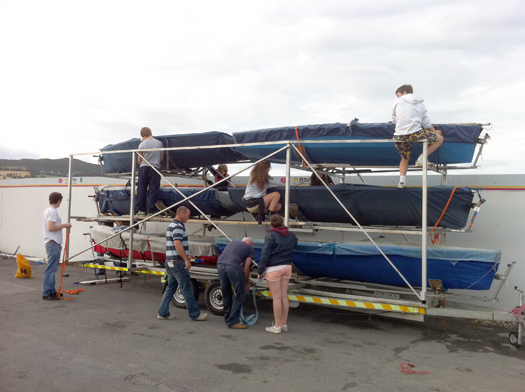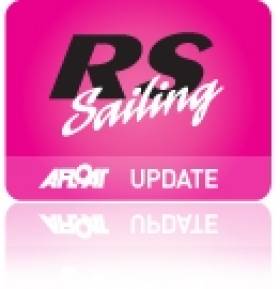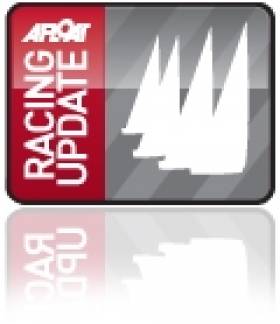Displaying items by tag: RS200
RS Sailors Heading North to Cushendall
The 2011 RS400 and RS200 Traveller Series draws to a close this weekend with the National Championships taking place at Cushendall Co. Antrim.
Two strong fleets of over 40 boats in total are expected.
In the RS400's Simon Herriott of Greystones SC, who scored some very impressive top ten results in the 86 boat UK Nationals is going to have some notable competition with the recently crowned Irish Fireball National Champions and Cushendall locals Barry McCartin and Conor Kinsella rumoured to be entered.

Greystones SC is bringing five 'under 18' boats and more boats for sailors in their late teens /early twenties to Cushendall this weekend. The Club's hard work getting kids into fast doublehanders is bearing fruit. See more on this initiative here. Photo: Sarah Byrne
Also bolstering the fleet is multiple Laser regional champion Paul McMahon, who also has plenty of asymmetric experience from his time in the SB3 fleet. Along with the Irish contingent some of the hotly contested UK fleet may make the trip across.
In the RS200 fleet the season long battle between Greystones rivals Roy Van Maanen and Graeme Noonan is set to continue. But the Wicklow 200's may not have it all there own way, with Clive Coffey and Emily Smith sure to be contention.
RS 200: the 'ideal' next step for Irish Youth Sailing?
Questions over the next step for juniors after the RS Feva point to the bigger RS200 writes Feva sailor Ciara Byrne
The RSFeva has become the world's best selling two-person dinghy in recent years with fleets also growing in clubs all over Ireland. It is fast becoming the most popular and widespread choice for teenagers and youth sailors who enjoy competitive, active and exciting sailing.
However many questions were being asked recently at the RSFeva Nationals, held in Crosshaven, Co. Cork, regarding the next step for young, talented sailors who wish to continue racing in large fleets without the difficult transition of transferring from the Feva into a larger, unfamiliar dinghy. This uncertainty has led to many sailors dropping out of sailing altogether, while the remainder have split the fleet into Lasers, the 420/470 or moved on to cruisers.
However these dinghies require a lot of time and effort of getting used to, leaving some sailors frustrated and also, less motivated. To avoid this altogether, there is one simple solution: the RS200.
The RS200 is a spacious, one-design, double-handed, hiking, high-performance dinghy which has developed a huge following at club, circuit and championship level in the UK with a growing fleet in Ireland. A pivoting centreboard and rudder allow easy launch and recovery with a thwart giving the crew a comfortable position for light winds. With the asymmetric spinnaker, similar rigging and a similar design, it can be considered as a larger and faster Feva which makes for an easy changeover and the most logical and simple step up.
The ideal weight for an RS200 is 115-145kg (18-23 stone) which allows people of all ages to sail and race effectively in this dinghy. Ideal for teenagers emerging from the Feva, parents, youths, couples, friends and relatives can also come together which enhances the family and social scene.
Even though the 420 has a larger total sail area, the RS200's asymmetric spinnaker of over eight square metres, with a smoother single line hoist and drop system, similar to the Feva's. makes for a faster boat and requires greater tactical and more exciting downwind sailing. This encourages competitive racing and enhanced racing skills.

An RS200 at full speed off Greystones. Photo: Fiachra Etchingham
A maintenance free hull, made of lightweight polyester GRP ensures a long competitive life and second hand boats can be in very good condition so that older hulls are without the disadvantage experienced in fleets such as the 420. Furthermore, every hull comes from the same manufacturer giving no subtle advantage to any one boat; therefore racing just comes down to the sailors' tactics, boat handling and general knowledge of sailing and racing.
While the RS200 is not an Olympic class, there are large UK and Irish fleets which are active and competitive. Johnathan Lewis, a UK Feva coach and RS200 sailor, strongly encourages Feva graduates to move into the RS200 as it is an easy transition and makes for fun and exciting sailing. RS200 fleets are strong in Irish clubs such as those in Northern Ireland including Ballyholme, Newcastle and Cushendall as well as Greystones Sailing Club in Co. Wicklow.
Greystones Sailing Club boasts probably the largest asymmetric dinghy fleet in Ireland with fifty five asymmetric dinghies, twenty one of those being RSFevas and the majority of the remainder being RS200s. Recognising the RS200 as the natural progression from the Feva, ages range from fifteen to fifty five across the RS200 and RS400 fleets in the Club, with most of these boats competing in national events in Ireland, and some in the UK and further afield.

Rounding a mark in the RS200. Photo: Fiachra Etchingham
As fleets build in Dún Laoghaire and Howth yacht clubs, the RS200 is gradually becoming a popular progression from the Feva, and with the RS400 as a follow on boat for larger crews, young sailors can remain involved and spirited in asymmetric racing. The RS200 satisfies a thirst for speed and pace which generates more exciting, competitive and enjoyable sailing for those emerging from Feva fleet.
A Dublin Sailor (who has asked not to be named) has sent us comments on this story:
As one involved in junior and youth sailing at club level, one of the big decisions that faces youths is where to go after junior classes such as Optimists, Toppers, Fevas. Like any other sport, there is a high attrition rate after the age of 14 / 15, especially among girls which is an even greater shame as they can compete on a par with the guys.We need a class that will keep youths engaged. The 420 & 29er are great boats but require higher levels of boathandling, are much more competitive and tend to attract the top sailors. They also suffer from an inability to match up crews who will stick together - teenagers chop and change all the time and its difficult to race a boat like a 420 / Fireball / 29er wihout a constant crew partnership.
We need a boat/class that:
- Enables swapping around of crews without a major impact on the boathandling / teamwork. A sailor's plans for the weekend / event / season are not scuppered because of crewing issues.
- Does not need a highly competent crew (e.g. ability to trapeze and fly / gybe a kite etc.) so that sailors can sail with their mates who may not necessarily be top-notch sailors but who can acquit themselves well in a slightly less complex boat.
- Has a good mixed social scene which is the most important element of any class, youth or otherwise.
- Does not cost the earth in terms of purchase price, is easy on wear & tear on kit (hence replacement & upgrade costs) or does not go soft and become uncompetitive needing a new hull after three to five years etc
- Has international competition that is closeby (UK, FR, Bel, Ned etc) for those aspiring to a bit more
- Has a motiviated class structure to help grow the class.
The fear is that we are starting out another class that will dilute the current youth class efforts. However I believe that the 420 and 29er will hold their own and continue to attract top sailors with ISAF ambitions.
On the other hand, if we continue to support these we will continue to lose the middle ground (and majority) of young sailors from our sport. Youths are fickle enough and if its too much hassle to deal with all the challenges of getting afloat they just won't bother - sad but true.
The ISA needs to take a lead in this and while its Olympic ambitions are great to see, it will fail the sport as a whole if it does not tackle this gaping need in its portfolio of support.
I believe that the RS200 and R2400 provide the best solution to these challenges. They appear well-built and the manufacturer certainly appears well organised and gets involved.
Looking from outside and without any vested interests (other than the health of junior and youth sailing) the RS's get my vote as a class that can make a radical difference.
Both competitors and organisers were not very optimistic on Friday evening with an ominous forecast on the Windguru web site of gusts up to a maximum of "5 knots". Thankfully even the Internet can get it wrong sometimes and everyone was pleasantly surprised when they were greeted with a steady 12 to 15 knots Southerly outside Greystones Harbour. The blue sky and sunshine providing the welcome bonus of an early sea-breeze.
With a strong tide which apparently runs South for ten hours of every twelve hour tidal cycle, judging lay-lines both up and down wind on the windward leeward courses was tricky to say the least. Though it was fair to say all crews were happy to have the tidal push for the up wind beats as it was full hiking conditions for all of day's four lap races.
In the 400 fleet Liam Donnelly took race one of the day. Greystones SC Commodore Simon Herriott suffered a breakage in race one but recovered in style to win the next two races.
In the 200 fleet Roy Van Maanen posted a perfect score card winning all three races of the day.
On day two a short postponement was followed by two light air races. Finding some pressure and managing to stay in it was the priority. This led to some dramatic place changes particularly on the down wind legs, were calling a gybe at the correct time was the difference between getting to the bottom mark in first or last place.
The sea-breeze kicked in just in time to provide plenty of excitement for the final race of the series. Amongst the 400 fleet there were four boats with the potential to take the event going into the last race. In the end Liam Donnelly and his crew, Andrew Vaughan from the Royal North prevailed in the stronger breeze taking the 400 Southerns trophy North.
In the 200's Roy Van Maanen had the luxury of discarding a 2nd to win the event comfortably. The battle for second was a little tighter with Graeme Noonan taking second place on count back from Sean Clery.
RS400 Results:
1st Liam Donnelly
2nd Simon Herriott
3rd Michael McAllister
RS200 Results:
1st Roy Van Maanen
2nd Graeme Noonan
3rd Sean Clery
Next up for the Irish RS fleet is Newcastle Co.Down. Check out www.irishrs.com for more information or to arrange test sail in an RS200 or RS400.































































